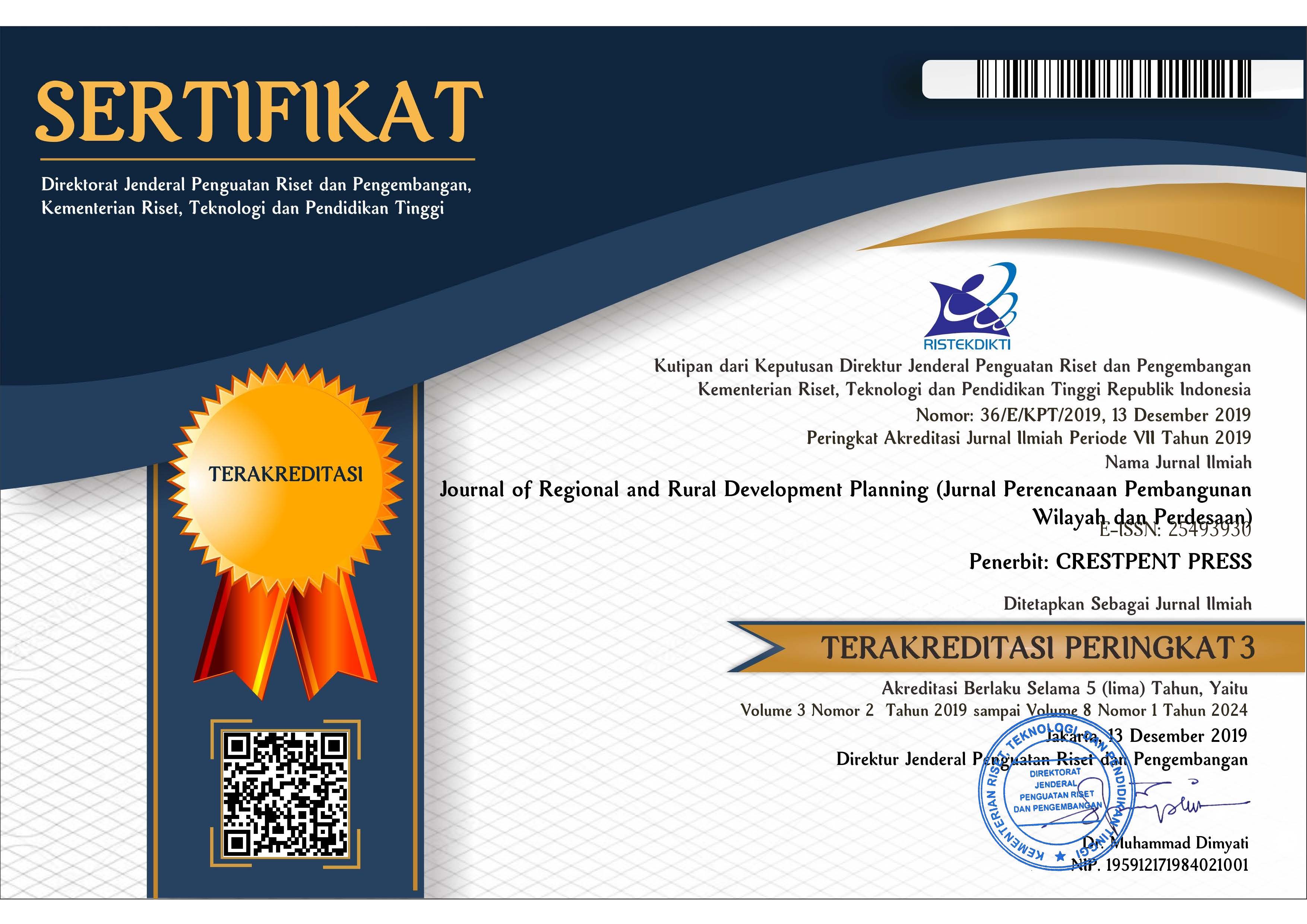Ketimpangan, Pola Spasial, dan Kinerja Pembangunan Wilayah di Provinsi Jawa Timur
Abstract
Disparity, Spatial Pattern, and Performance of Regional Development in East Java Province
Development is a multidimensional process that aims to generate significant changes in the betterment of people's lives. However, development does not always able to form regional balance. The phenomenon of disparity always shades the regional development process. As a province with the highest number of regencies and cities, the development of East Java Province is inseparable from the phenomenon of disparity. This study aimed to analyze the performance, regional disparities, and spatial autocorrelation of regional development in East Java Province in 2017. Performance of regional development was measured using TOPSIS analysis. Level of regional disparity was calculated by the Coefficient Variation (CV). Spatial pattern of development performance was explored through analysis of spatial autocorrelation by Moran Index and Local Indicator of Spatial Autocorrelation (LISA). Results of analysis on regional development performance show that Kediri City had the highest performance in East Java Province, meanwhile Tuban Regency had the lowest performance. At the regional level, Pantura (North Coast) and Central Region have higher regional development performance average compared to Pansela (South Coast), Tapal Kuda, and Madura regions. Regional disparity in East Java Province occur between regions and within regions (between regencies/cities). Pantura is the region with the highest regional development performance disparity, meanwhile Madura region is relatively homogenous with low development performance. Result of Moran and LISA analysis interpret that spatial and contiguity aspects effect regional development significantly which tends to form a cluster pattern. Therefore, spatial factors and regional linkage are essential elements in regional development.
References
Anwar, A. (2017). Ketimpangan Spasial Pembangunan Ekonomi dan Modal Manusia di Pulau Jawa : Pendekatan Explatory Spatial Data Analysis. Asian Journal of Innovation and Entrepreneurship, 2 (2), 90–109.
BPS Jatim. (2018). Provinsi Jawa Timur dalam Angka 2018. BPS Provinsi Jawa Timur.
Brotodewo, N. (2010). Penilaian Indikator Transportasi Berkelanjutan pada Kawasan Metropolitan di Indonesia. Jurnal Perencanaan Wilayah dan Kota, 21 (3), 165–182.
Cobbinah, P. B., & Black, R. (2011). Reflections on Six Decades of The Concept of Development : Evaluation and Future. Journal of Sustainable Development in Africa, 13 (7), 143–158.
Dai, X., & Zhang, J. (2011). The TOPSIS Analysis on Regional Disparity of Economic Development in Zhejiang Province. Canadian Social Science, 7 (5), 135–139.
Dhiyaa’ulhaq, M. (2017). Analisis Penyebaran Kemiskinan dan Pengaruh Industri Mikro dan Kecil terhadap Kemiskinan di Daerah Istimewa Yogyakarta. Institut Pertanian Bogor.
Ezkirianto, R. (2013). Analisis Keterkaitan Antara Indeks Pembangunan Manusia dan PDRB Perkapita di Indonesia (Periode Tahun 2006-2011). Institut Pertanian Bogor.
Griffith, D., & Chun, Y. (2013). Spatial Autocorrelation and Spatial Filtering. Handbook of Regional Science, M. M. Fischer & P. Nijkamp Ed., 1477–1507. Berlin Heidelberg: Springer Reference.
Harmes, Juanda, B., Rustiadi, E., & Barus, B. (2017). Pemetaan Efek Spasial pada Data Kemiskinan Kota Bengkulu. Journal of Regional and Rural Development Planning, 1 (2), 192–201.
Indrashanty, A., & Legowo, P. S. (2016). Aksesibilitas dan Mobilitas Transportasi di Provinsi Bengkulu dalam Konteks Negara Maritim dan Penguatan Daerah Tertinggal. Jurnal Penelitian Transportasi Multimoda, 14 (2), 95–104.
Kansky, K., & Danscoine, P. (1989). Measures of Network Structure. Flux, Special, 89–121.
Krimi, M. S., Yusop, Z., & Hook, L. S. (2010). Regional Development Disparities in Malaysia. Journal of American Science, 6 (3), 70–78.
Lee, J., & Wong, D. W. S. (2001). Statistical Analysis with Arcview GIS. John Wiley & Sons, Inc.
Lumbatoruan, E. P., & Hidayat, P. (2013). Analisis Pertumbuhan Ekonomi dan Indeks Pembangunan Manusia (IPM) Provinsi di Indonesia. Jurnal Ekonomi dan Keuangan, 2 (2), 14–27.
Mahi, A. K. (2016). Pengembangan Wilayah: dan Aplikasi Teori (Pertama). Kencana.
Munibah, K., Widiatmaka, & Widjaja, H. (2015). Spatial Distribution of Regional Development Level Using Spatial Autocorrelation Approach (a Case Study: Cianjur Regency, West Java). The 1st International Conference of Indonesian Society for Remote Sensing, 158–164. Surabaya: Geomatic Engineering, Institut Teknologi Sepuluh Nopember (ITS) Surabaya.
Panjaitan, W. M. (2012). Penerapan Regresi Spasial pada Pemodelan Kasus Ketergantungan Spasial (Studi Kasus: Indeks Pembangunan Manusia di Indonesia Tahun 2010). Institut Pertanian Bogor.
Pratiwi, M. C. Y., & Kuncoro, M. (2016). Analisis Pusat Pertumbuhan dan Autokorelasi Spasial di Kalimantan. Jurnal Ekonomi dan Pembangunan Indonesia, 16 (2), 81–104.
Putra, F. S. (2017). Analisis Spasial Produk Domestik Regional Bruto Tengah, Kabupaten/Kota di Provinsi Jawa. Universitas Islam Indonesia.
RPJMD Jatim. (2014). Rencana Pembangunan Jangka Menengah Daerah Provinsi Jawa Timur tahun 2014-2019. Pemerintah Provinsi Surabaya.
Rustiadi, E., Saefulhakim, S., & Panuju, D. R. (2011). Perencanaan dan Pengembangan Wilayah. Crestpent Press dan Yayasan Obor.
Salonen, M. (2014). Analysing Spatial Accessibility Patterns with Travel Time and Distance Measures : Novel Approaches for Rural and Urban Contexts. University of Helsinki.
Sulistyono, D., Mawardi, A. F., & Widjanarko. (2018). Penentuan Prioritas Pembangunan Infrastruktur Jalan Wilayah Kabupaten/Kota di Provinsi Jawa Timur yang Mempunyai Aksesibilitas Rendah. Seminar Nasional Perubahan Teknologi Sosial 3. UPT PMK Sosial Humaniora. Fakultas Bisnis dan Manajemen. Institut Teknologi Sepuluh Nopember.
Todaro, M. P., & Smith, S. C. (2011). Pembangunan Ekonomi. Erlangga.
Tzeng, G.-H., & Huang, J.-J. (2011). Multiple Attribute Desition Making: Methods and Application. CRC Press.
UNDP. (1990). Human Development Report. New York.
Yu, D., & Wei, Y. D. (2008). Spatial Data Analysis of Regional Development in Greater Beijing, China, in A GIS Environment. Regional Science, 87 (1), 97–117.
Copyright (c) 2019 Journal of Regional and Rural Development Planning (Jurnal Perencanaan Pembangunan Wilayah dan Perdesaan)

This work is licensed under a Creative Commons Attribution-ShareAlike 4.0 International License.




.png)














